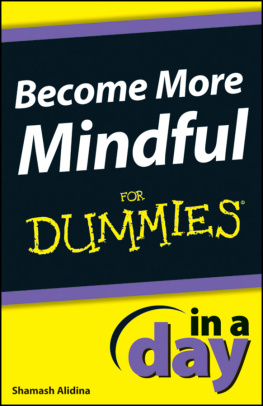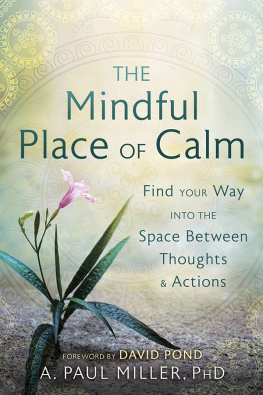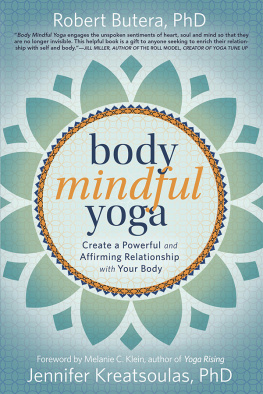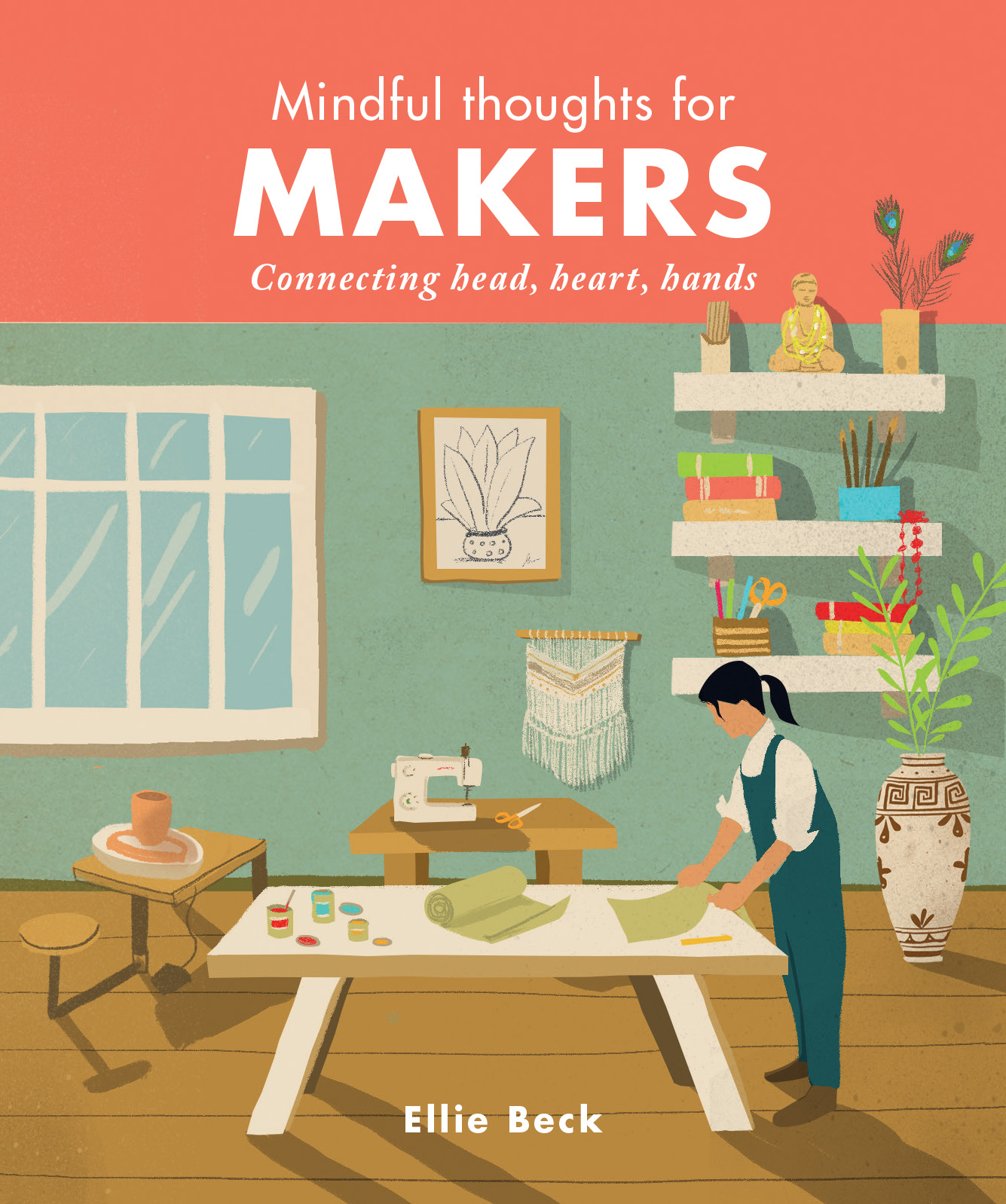Mindful thoughts for
MAKERS
Connecting head, heart, hands
Ellie Beck

INTRODUCTION
On Being a
Maker
Being a maker is an innate part of our human experience, something we are born with, but many of us seem to have forgotten this. The busyness of our lives, the rush of societys expectations and the increasing use of technology all pull us away from the work of connecting our hands with our heart.
Our ancestors were makers, without even naming themselves as such. And we are all makers still, whether we are knitting a garment, turning wood on a lathe, hand-crafting a pair of earrings, decorating a cake or sewing a special quilt for our family. Makers arent necessarily artists or crafters, in the sense of what those words might mean to you. They are simply people who tinker, design, invent, create, play, explore and make something. Makers can be artists, bakers, potters or ceramicists, jewellers, woodworkers, gardeners, sewers, tailors or dressmakers the many creative activities that fit under the term maker are too long to list. To be human is to be a maker.

In our busy lives, we makers create many things, yet we dont always lean into the stillness and quietness that can come from the experience of making. We rush to finish our project, to show it off on social media, to buy more materials to make something else, and the cycle of producing things continues. Yet, wouldnt it be beautiful if we could bring slow into our days and our lives, through the very simple act of learning how to enhance mindful moments in our making? To change our routines into a rhythm, and to replace the rush to finish a project with the quiet slowness of taking time to enjoy it. The process of making things can guide us to slow our breath and our bodies, to listen to our minds and connect with the whisper in our hearts.
Being a mindful maker can allow us to follow the curiosity of seeing where the journey might take us, to discover what we can learn about ourselves and our environment, and to change our outlook on life through the lessons that making can teach us.
My experience as a maker is so deeply ingrained in my daily life that sometimes I have to remind myself to use my making as a tool for my daily meditation, to still my mind and body, rather than simply making for makings sake alone. I can use my needle and thread to create small pockets of quiet time and to guide me into bringing more mindfulness to my whole life to remember the way I feel when Im quietly stitching and bring that feeling into the hectic noise of my days.
By sitting with our practice, as a maker, and allowing our rituals and rhythms to guide us, we are able to delve into a deeper connection with being a maker, with our materials and tools, with the environment around us, and ultimately with our broader community, through a more intense sense of fulfilment and contentedness.
The Heart
of the
Maker
The term maker encompasses so many possibilities and such a variety of crafts and creative practices, media, projects, skills and techniques, that its almost impossible to narrow it down to any one group of people. Put simply, a maker is a person who makes or produces something, but I think it goes much deeper than that. I believe that we are all makers, if only wed give ourselves permission to become one, and do away with any rules of what a maker has to be.

Human beings are makers by nature, from our pre-history right through to today. Setting the intention to make something is about tapping into our innate creativity, re-learning the things that a generation seems to have pushed aside in favour of a mass-produced world, and sharing our unique visual voice with our fellow humans. Being a maker can be as diverse as sewing ourselves a new outfit, constructing a lightshade, building a tree house or forming clay into pots. The wonderful thing is there are no rules for what a maker is or has to be, and no expectations that you should only make one sort of thing for your whole life. Indeed, you dont even need to be very good at making, in order to be a maker.
The important thing, in my mind at least, is that you need to enjoy the making that at least some of the time you find satisfaction and inspiration and perhaps even discover yourself in the things you make. You dont need to finish your projects or share them with the world to be a maker. The heart of the maker lies not in the finished items, but in the doing of the project, the making of the thing.
WHY WE MAKE
Humans have been making since time began, to meet our daily needs such as gathering food and sheltering our bodies, and as an artistic outlet to tell our stories or share our experiences. We make today for many similar reasons. Many makers the world over create something because deep down they have a feeling, an urge to share a story, to show their thoughts, feelings or emotions.
Growing up in an artistic family I never thought much about why I make, but looking at the world now and the increasing numbers of people turning to making, I realize that why we make things today is also quite different to the reasons our ancestors did. While for them it was a necessity to make their own soap, quilts, bread, clothing and furniture, today we can easily and cheaply buy those things with little thought of how they were produced sometimes by a person, sometimes by a machine. Mass-produced, generic stuff fills our lives, and many of us have started to notice a disconnect from our possessions, and a disquiet about the environmental effects of our modern life. These feelings, combined with a generation of children who didnt learn basic sewing and other making skills from their two-parent working families, have led to a dramatic shift towards DIY, craft clubs, online forums and creative community collaborations.
Thanks to the Internet, makers can now share, learn and connect worldwide, inspiring a younger generation of makers, while learning from peers or an older generation. The increase of at-home ceramics studios and newly skilled spoon carvers or basket weavers is indicative of the modern maker. Our ancestors made these items for everyday use, for mundane moments or creative rituals, and today makers are picking up the tools, attending a workshop or asking the advice of a long-time maker from their community. We are doing this to tap into the truth of how things are made, and to honour the history of our regions, all while mindfully giving up on mass-produced items that have a cost both to the environment and to the communities forced into making them.
MINDFUL MAKING
Being a maker can be as joyful as using our hands to create something. But by connecting our head and heart to the process, through mindful thoughts, we can tap into a richer depth of our creative practice. The act of joining hands, heart and head together creates something bigger than ourselves, while also allowing us to better understand ourselves. The things we make with our hands have the power to create change in our minds and our hearts.









